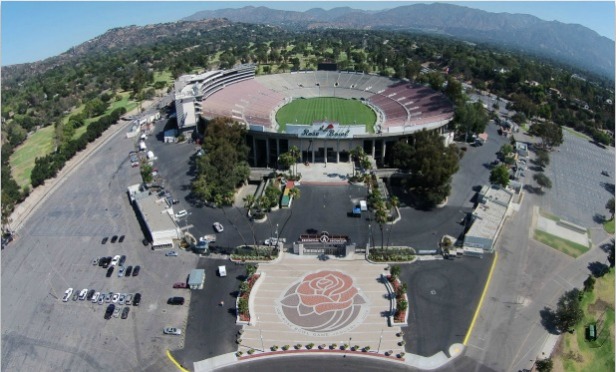
LOS ANGELES—Bernards has completed a more than decade-long renovation project on the Rose Bowl stadium in Pasadena. The project and most recent renovation phase included a new technology infrastructure, which brings the 100-year-old building into the 21st century. The total cost of the renovations, which started in 2005 and included work from a joint venture between Bernards and Barton Malow for a portion of the renovations, is $182.7 million.
“This has been a very rewarding Project for Bernards,” Carl Magness, senior project manager at Bernards, tells GlobeSt.com. “We have a tremendous sense of accomplishment in knowing that by completing this renovation, we have contributed to fulfilling the Rose Bowl Operating Committee's commitment to their key audiences. It's a great feeling to finish a first class project like this that will maintain the Rose Bowl Stadium's status as an iconic venue for years to come.”
While the renovation project included the addition of technology and wireless capabilities, Bernards also worked to preserve the history of the stadium. Additions include the Terry Donahue Pavilion, with 54 luxury suites, 1,200 club seats and 48 large boxes as well as new press boxes and a broadcast center. The structure also has a separate level for day-to-day operations and coaching staff. The renovations also added a brick donor plaza, updated the Court of Champions and stadium entry gates and added new signature signage, 10 new LED-advertising panels and new LED video board and scoreboards, while also renovating and reconstructing the vintage 1940's scoreboard on the Southend of the stadium. “The Renovation Project has truly been a success in that the Rose Bowl has realized their vision for the stadium, including preserving the historical value, improving the fan experience and producing a consistent revenue stream for the future,” adds Magness. “In fact, Margo Mavridis, RBOC's Stadium Architect and Bernards' primary contact throughout the renovation project, is in the thick of a number of sporting activities this week that are going extremely well and benefiting from the stadium improvements.”
The renovations took additional time because the stadium remained 100% fully operational during the construction process. “In order to do that, there were challenges in doing the construction and the phasing of the actual work. Knowing that the stadium operations would continue throughout the entire project, there had to be keen logistical site planning, as well as back up plans in order for the project to be successful,” says Magness. “Additionally, the engineering and logistics for widening the tunnels was a technical marvel.”
Now that the renovations are complete, the Rose Bowl is elevated to a new status, according to Magness. He adds, “The extensive renovation maintains the Rose Bowl's status as a viable sports and entertainment stadium and positions it for much future success.

LOS ANGELES—Bernards has completed a more than decade-long renovation project on the Rose Bowl stadium in Pasadena. The project and most recent renovation phase included a new technology infrastructure, which brings the 100-year-old building into the 21st century. The total cost of the renovations, which started in 2005 and included work from a joint venture between Bernards and Barton Malow for a portion of the renovations, is $182.7 million.
“This has been a very rewarding Project for Bernards,” Carl Magness, senior project manager at Bernards, tells GlobeSt.com. “We have a tremendous sense of accomplishment in knowing that by completing this renovation, we have contributed to fulfilling the Rose Bowl Operating Committee's commitment to their key audiences. It's a great feeling to finish a first class project like this that will maintain the Rose Bowl Stadium's status as an iconic venue for years to come.”
While the renovation project included the addition of technology and wireless capabilities, Bernards also worked to preserve the history of the stadium. Additions include the Terry Donahue Pavilion, with 54 luxury suites, 1,200 club seats and 48 large boxes as well as new press boxes and a broadcast center. The structure also has a separate level for day-to-day operations and coaching staff. The renovations also added a brick donor plaza, updated the Court of Champions and stadium entry gates and added new signature signage, 10 new LED-advertising panels and new LED video board and scoreboards, while also renovating and reconstructing the vintage 1940's scoreboard on the Southend of the stadium. “The Renovation Project has truly been a success in that the Rose Bowl has realized their vision for the stadium, including preserving the historical value, improving the fan experience and producing a consistent revenue stream for the future,” adds Magness. “In fact, Margo Mavridis, RBOC's Stadium Architect and Bernards' primary contact throughout the renovation project, is in the thick of a number of sporting activities this week that are going extremely well and benefiting from the stadium improvements.”
The renovations took additional time because the stadium remained 100% fully operational during the construction process. “In order to do that, there were challenges in doing the construction and the phasing of the actual work. Knowing that the stadium operations would continue throughout the entire project, there had to be keen logistical site planning, as well as back up plans in order for the project to be successful,” says Magness. “Additionally, the engineering and logistics for widening the tunnels was a technical marvel.”
Now that the renovations are complete, the Rose Bowl is elevated to a new status, according to Magness. He adds, “The extensive renovation maintains the Rose Bowl's status as a viable sports and entertainment stadium and positions it for much future success.
© Touchpoint Markets, All Rights Reserved. Request academic re-use from www.copyright.com. All other uses, submit a request to asset-and-logo-licensing@alm.com. For more inforrmation visit Asset & Logo Licensing.